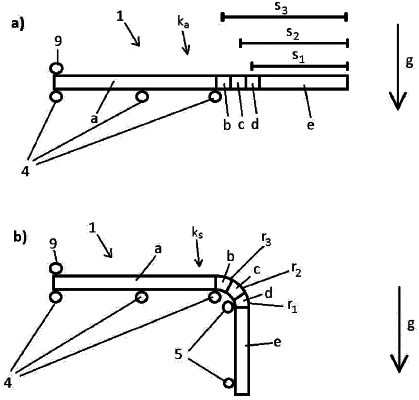| CPC C03B 23/0256 (2013.01) [B32B 17/06 (2013.01); B32B 17/10036 (2013.01); B32B 17/10128 (2013.01); B32B 17/10871 (2013.01); B32B 17/10889 (2013.01); C03B 23/0258 (2013.01); B32B 2315/08 (2013.01); B32B 2419/00 (2013.01); B32B 2605/006 (2013.01); B32B 2605/08 (2013.01)] | 13 Claims |

|
1. A method for shaping a glass pane, the method comprising:
heating the glass pane;
one-dimensionally bending the glass pane until the glass pane has reached a shape that corresponds to a predefined target contour, wherein at least one exterior force is exerted on the glass pane to cause the one-dimensional bending of the glass pane, wherein the at least one exterior force is at least one of: a weight force caused by a weight of the glass pane, a force that is transferred by a support on which the glass pane rests to a surface region of the glass pane which rests on the support, a force that is transferred at an edge of the glass pane into the glass pane by a mount into which the edge of the glass pane is clamped, or a pressure force transferred by one or more pressure strips to a surface of the glass pane; and
changing a local curvature of the glass pane over time, wherein the changing of the local curvature is controlled such that the surface of the glass pane concurrently achieves the predefined target contour at all points of the surface that do not remain static, by:
setting a temperature, and thus a viscosity, of the glass pane during the one-dimensional bending of the glass pane so as not to be constant as a function of location, wherein a curvature is imparted to an inner section of the glass pane, the inner section of the glass pane being disposed between a first exterior section and a second exterior section, wherein no curvature is imparted to the first and second exterior sections, and the temperature is maintained below a deformation temperature in the first and second exterior sections, wherein in the inner section, a temperature of the glass pane is varied locally along a first extension direction of the glass pane as a function of location, and is set so as to be constant in a second extension direction extending orthogonally with respect to the first extension direction as a function of location, so that two or more strip-shaped regions having differing temperatures are present in the inner section, wherein the two or more strip-shaped regions in the inner section are heated towards target temperatures that spatially increase steadily from one strip-shaped region to another, a first stripped shaped region of the two or more strip-shaped regions, which is, located closest to the first exterior section, heated to a lowest target temperature among the target temperatures in the at least two strip-shaped regions, and a last strip-shaped region of the two or more strip-shaped regions, which is located closest to the second exterior section, being heated to a highest target temperature among the temperatures in the at least two strip-shaped regions.
|